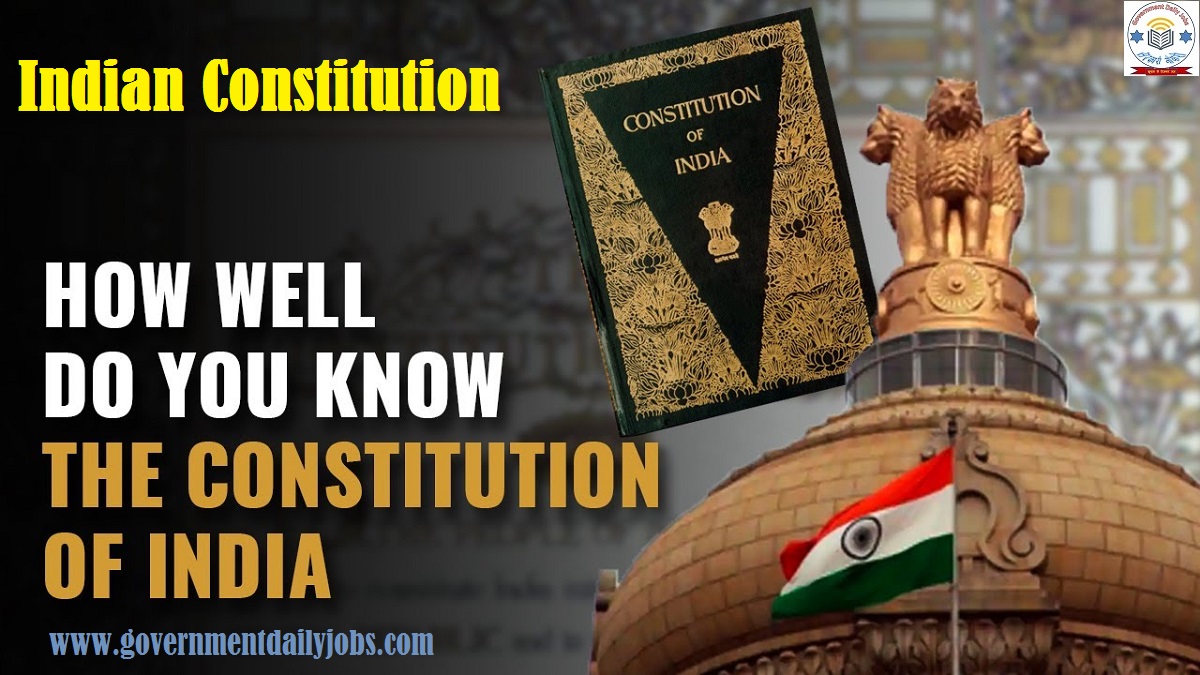The Republic is governed in terms of the Constitution of India which was adopted by the Constituent Assembly on 26th November, 1949 and came into force on 26th January, 1950. The Constitution provides for a Parliamentary form of government which is federal in structure with certain unitary features.
The Constitution of India: Important Facts about Constitution of India
Indian Constitution
Sovereign:
India is an independent and self-governing nation.
Socialist:
The government should work to create a more just and equitable society.
Secular:
All religions are equal and the government should not favor any one religion
over another.
Democratic:
The people are the ultimate source of power and they have the right to choose
their own leaders.
Republic:
The head of state is not a hereditary monarch, but an elected president.
Justice:
All citizens are entitled to equal justice under the law.
Liberty:
Citizens have the freedom to think, speak, and act as they please, subject to
certain limits.
Equality:
All citizens are equal before the law and have equal opportunities to succeed.
Fraternity:
Citizens should treat each other with respect and dignity.
These
keywords are not only found in the Preamble to the Constitution, but they are
also reflected throughout the text of the Constitution. They provide a
blueprint for the kind of society that India aspires to be.
Indian Parliament related Questions and Answers
In addition
to these keywords, I would also add the following to the list of the best
keywords of the Indian Constitution:
Dignity:
The Constitution guarantees all citizens the right to live with dignity.
Progress:
The Constitution envisions a society that is constantly moving forward and
improving the lives of its citizens.
Unity:
The Constitution seeks to unite all Indians, regardless of their religion,
caste, or ethnicity.
Indian Constitution Key Topics
·
Impact of the Indian
Constitution on gender equality
·
Role of the Indian
Constitution in protecting minority rights
·
Challenges to the
implementation of the Indian Constitution
·
Interpretation of the Indian
Constitution by the Supreme Court
·
Comparative analysis of the
Indian Constitution with other constitutions
·
History of the drafting of the
Indian Constitution
·
Role of the Constituent
Assembly in shaping the Indian Constitution
·
Amendments to the Indian
Constitution
·
Implementation of the
Directive Principles of State Policy
·
Role of the judiciary in
upholding the supremacy of the Indian Constitution
·
Impact of the Indian
Constitution on the social and economic development of India
Here are some more keywords specific articles of the Indian Constitution:
·
Article 14 of the Indian
Constitution: Right to Equality
·
Article 15 of the Indian
Constitution: Prohibition of Discrimination on Grounds of Religion, Race,
Caste, Sex or Place of Birth
·
Article 16 of the Indian
Constitution: Equality of Opportunity in Matters of Public Employment
·
Article 21 of the Indian
Constitution: Protection of Life and Personal Liberty
·
Article 25 of the Indian
Constitution: Freedom of Religion
·
Article 32 of the Indian
Constitution: Right to Constitutional Remedies
Indian Parliament related Questions and Answers
A. Speaker of Lok Sabah
B. President
C. Election Commissioner
D. A committee set up by the parliament
A. KVK Sundaram
B. GS Dhillon
C. Baliram Bahgat
D. Hukum Singh
A. 62 yrs
B. 68 yrs
C. 60 yrs
D. 65 yrs
A. Presidential form Govt.
B. Cabinet System of Government
C. Parliamentary System
D. Bicameral System of government
A. Seventh
B. Sixth
C. Fifth
D. Ninth
A. Pranab Mukerjee
B. Sushma Swaraj
C. Mrs.Meira Kumar
D. Dr. Manmohan Singh
A. federal
B. unitary
C. parliament
D. federal in form and unitary in spirit
A. directive principles
B. fundamental rights
C. preamble
D. Citizenship
A. Italian Constitution
B. Canadian Constitution
C. French Constitution
D. Constitution of USA
A. 12 years
B. 14 years
C. 16 years
D. 18 years
A. Birth
B. Descent
C. Naturalization
D. Acquiring Property
A. State Legislatures
B. Parliament
C. President
D. Attorney General
A. Council of states
B. The Upper House
C. The House of the People
D. Parliament
A. President of India
B. Vice President of India
C. Prime Minister of India
D. None of the above
A. Fifth
B. Sixth
C. Seventh
D. Eighth
A. Jawaharlal Nehru
B. Gulzari Lal Nanda
C. Lal Bahadur Shastri
D. John Mathai
A. Mahatama Gandhi
B. Dr BR Ambedkar
C. Jawaharlal Nehru
D. MN Roy
A. British Parliament
B. Federal Legislature
C. State Legislature
D. Government General
A. Aug 15, 1947
B. Jan 30, 1948
C. Jan 26, 1950
D. Nov 26, 1929
A. July, 1948
B. July, 1950
C. July, 1947
D. August, 1947
Click here for Previous Question Papers
Click here
Click here
Click here
Click here
Click here
Click here
for Vice President of India
Selection Process
FAQ
Who founded
Indian Constitution?
What are the
main points of the Constitution of India?
Why is it
called Constitution of India?
Why is Indian
Constitution famous?
Tags
Indian
Constitution Pdf, Constitution of India Written By, What is Constitution, Introduction
to The Constitution of India, Father of Indian Constitution, The Indian
Constitution Project Pdf, How Many Articles in Indian Constitution, Introduction
to The Constitution Of India'' (Pdf)




Connect With Us